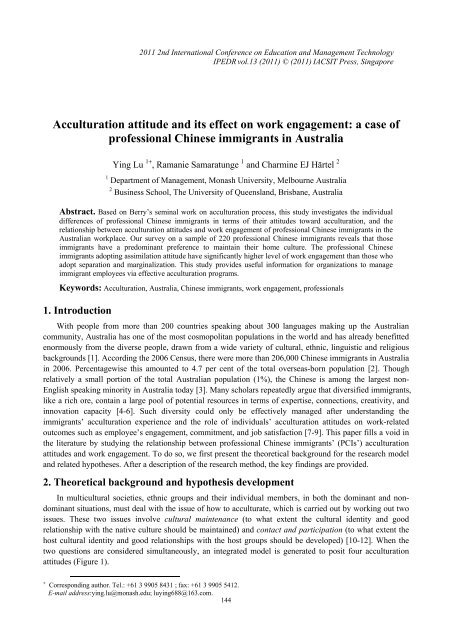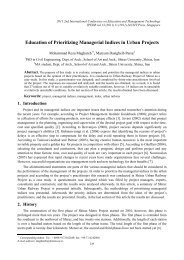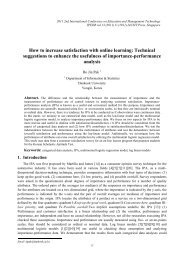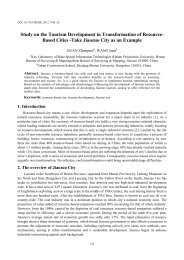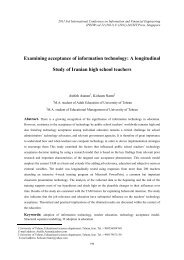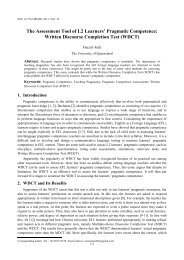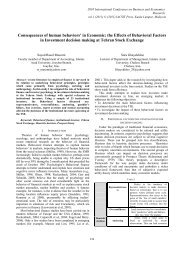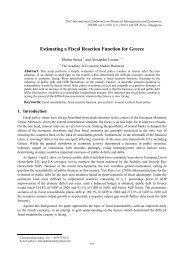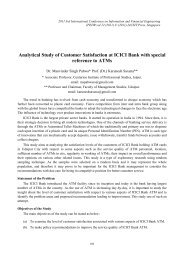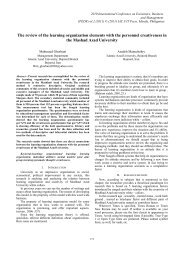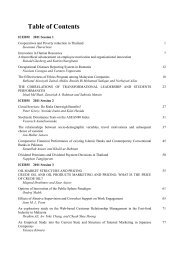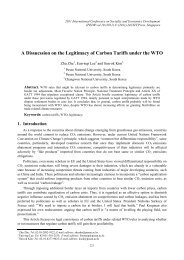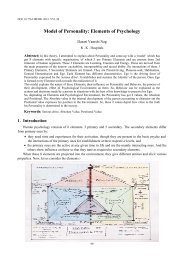Acculturation attitude and its effect on work engagement: a ... - ipedr
Acculturation attitude and its effect on work engagement: a ... - ipedr
Acculturation attitude and its effect on work engagement: a ... - ipedr
You also want an ePaper? Increase the reach of your titles
YUMPU automatically turns print PDFs into web optimized ePapers that Google loves.
2011 2nd Internati<strong>on</strong>al C<strong>on</strong>ference <strong>on</strong> Educati<strong>on</strong> <str<strong>on</strong>g>and</str<strong>on</strong>g> Management Technology<br />
IPEDR vol.13 (2011) © (2011) IACSIT Press, Singapore<br />
<str<strong>on</strong>g>Acculturati<strong>on</strong></str<strong>on</strong>g> <str<strong>on</strong>g>attitude</str<strong>on</strong>g> <str<strong>on</strong>g>and</str<strong>on</strong>g> <str<strong>on</strong>g>its</str<strong>on</strong>g> <str<strong>on</strong>g>effect</str<strong>on</strong>g> <strong>on</strong> <strong>work</strong> <strong>engagement</strong>: a case of<br />
professi<strong>on</strong>al Chinese immigrants in Australia<br />
Ying Lu 1+ , Ramanie Samaratunge 1 <str<strong>on</strong>g>and</str<strong>on</strong>g> Charmine EJ Härtel 2<br />
1 Department of Management, M<strong>on</strong>ash University, Melbourne Australia<br />
2 Business School, The University of Queensl<str<strong>on</strong>g>and</str<strong>on</strong>g>, Brisbane, Australia<br />
Abstract. Based <strong>on</strong> Berry’s seminal <strong>work</strong> <strong>on</strong> acculturati<strong>on</strong> process, this study investigates the individual<br />
differences of professi<strong>on</strong>al Chinese immigrants in terms of their <str<strong>on</strong>g>attitude</str<strong>on</strong>g>s toward acculturati<strong>on</strong>, <str<strong>on</strong>g>and</str<strong>on</strong>g> the<br />
relati<strong>on</strong>ship between acculturati<strong>on</strong> <str<strong>on</strong>g>attitude</str<strong>on</strong>g>s <str<strong>on</strong>g>and</str<strong>on</strong>g> <strong>work</strong> <strong>engagement</strong> of professi<strong>on</strong>al Chinese immigrants in the<br />
Australian <strong>work</strong>place. Our survey <strong>on</strong> a sample of 220 professi<strong>on</strong>al Chinese immigrants reveals that those<br />
immigrants have a predominant preference to maintain their home culture. The professi<strong>on</strong>al Chinese<br />
immigrants adopting assimilati<strong>on</strong> <str<strong>on</strong>g>attitude</str<strong>on</strong>g> have significantly higher level of <strong>work</strong> <strong>engagement</strong> than those who<br />
adopt separati<strong>on</strong> <str<strong>on</strong>g>and</str<strong>on</strong>g> marginalizati<strong>on</strong>. This study provides useful informati<strong>on</strong> for organizati<strong>on</strong>s to manage<br />
immigrant employees via <str<strong>on</strong>g>effect</str<strong>on</strong>g>ive acculturati<strong>on</strong> programs.<br />
Keywords: <str<strong>on</strong>g>Acculturati<strong>on</strong></str<strong>on</strong>g>, Australia, Chinese immigrants, <strong>work</strong> <strong>engagement</strong>, professi<strong>on</strong>als<br />
1. Introducti<strong>on</strong><br />
With people from more than 200 countries speaking about 300 languages making up the Australian<br />
community, Australia has <strong>on</strong>e of the most cosmopolitan populati<strong>on</strong>s in the world <str<strong>on</strong>g>and</str<strong>on</strong>g> has already benefitted<br />
enormously from the diverse people, drawn from a wide variety of cultural, ethnic, linguistic <str<strong>on</strong>g>and</str<strong>on</strong>g> religious<br />
backgrounds [1]. According the 2006 Census, there were more than 206,000 Chinese immigrants in Australia<br />
in 2006. Percentagewise this amounted to 4.7 per cent of the total overseas-born populati<strong>on</strong> [2]. Though<br />
relatively a small porti<strong>on</strong> of the total Australian populati<strong>on</strong> (1%), the Chinese is am<strong>on</strong>g the largest n<strong>on</strong>-<br />
English speaking minority in Australia today [3]. Many scholars repeatedly argue that diversified immigrants,<br />
like a rich ore, c<strong>on</strong>tain a large pool of potential resources in terms of expertise, c<strong>on</strong>necti<strong>on</strong>s, creativity, <str<strong>on</strong>g>and</str<strong>on</strong>g><br />
innovati<strong>on</strong> capacity [4-6]. Such diversity could <strong>on</strong>ly be <str<strong>on</strong>g>effect</str<strong>on</strong>g>ively managed after underst<str<strong>on</strong>g>and</str<strong>on</strong>g>ing the<br />
immigrants’ acculturati<strong>on</strong> experience <str<strong>on</strong>g>and</str<strong>on</strong>g> the role of individuals’ acculturati<strong>on</strong> <str<strong>on</strong>g>attitude</str<strong>on</strong>g>s <strong>on</strong> <strong>work</strong>-related<br />
outcomes such as employee’s <strong>engagement</strong>, commitment, <str<strong>on</strong>g>and</str<strong>on</strong>g> job satisfacti<strong>on</strong> [7-9]. This paper fills a void in<br />
the literature by studying the relati<strong>on</strong>ship between professi<strong>on</strong>al Chinese immigrants’ (PCIs’) acculturati<strong>on</strong><br />
<str<strong>on</strong>g>attitude</str<strong>on</strong>g>s <str<strong>on</strong>g>and</str<strong>on</strong>g> <strong>work</strong> <strong>engagement</strong>. To do so, we first present the theoretical background for the research model<br />
<str<strong>on</strong>g>and</str<strong>on</strong>g> related hypotheses. After a descripti<strong>on</strong> of the research method, the key findings are provided.<br />
2. Theoretical background <str<strong>on</strong>g>and</str<strong>on</strong>g> hypothesis development<br />
In multicultural societies, ethnic groups <str<strong>on</strong>g>and</str<strong>on</strong>g> their individual members, in both the dominant <str<strong>on</strong>g>and</str<strong>on</strong>g> n<strong>on</strong>dominant<br />
situati<strong>on</strong>s, must deal with the issue of how to acculturate, which is carried out by <strong>work</strong>ing out two<br />
issues. These two issues involve cultural maintenance (to what extent the cultural identity <str<strong>on</strong>g>and</str<strong>on</strong>g> good<br />
relati<strong>on</strong>ship with the native culture should be maintained) <str<strong>on</strong>g>and</str<strong>on</strong>g> c<strong>on</strong>tact <str<strong>on</strong>g>and</str<strong>on</strong>g> participati<strong>on</strong> (to what extent the<br />
host cultural identity <str<strong>on</strong>g>and</str<strong>on</strong>g> good relati<strong>on</strong>ships with the host groups should be developed) [10-12]. When the<br />
two questi<strong>on</strong>s are c<strong>on</strong>sidered simultaneously, an integrated model is generated to posit four acculturati<strong>on</strong><br />
<str<strong>on</strong>g>attitude</str<strong>on</strong>g>s (Figure 1).<br />
+ Corresp<strong>on</strong>ding author. Tel.: +61 3 9905 8431 ; fax: +61 3 9905 5412.<br />
E-mail address:ying.lu@m<strong>on</strong>ash.edu; luying688@163.com.<br />
144
In Figure 1, these two relevant issues are addressed using attitudinal dimensi<strong>on</strong>s represented by bipolar<br />
arrows. Generally positive or negative resp<strong>on</strong>ses (“yes” or “no” resp<strong>on</strong>ses) to these questi<strong>on</strong>s intersect to<br />
define four acculturati<strong>on</strong> strategies of assimilati<strong>on</strong>, integrati<strong>on</strong>, separati<strong>on</strong>, <str<strong>on</strong>g>and</str<strong>on</strong>g> marginalizati<strong>on</strong>. According<br />
to Berry [10, 13], when individuals do not want to maintain their original culture <str<strong>on</strong>g>and</str<strong>on</strong>g> aim at complete<br />
absorpti<strong>on</strong> into the host culture, they are hiring the assimilati<strong>on</strong> strategy. By c<strong>on</strong>trast, if individuals str<strong>on</strong>gly<br />
retain their cultural identity <str<strong>on</strong>g>and</str<strong>on</strong>g> view the relati<strong>on</strong>ships with host culture as unimportant, they are adopting the<br />
separati<strong>on</strong> strategy. When people are interested in maintaining their original culture during daily interacti<strong>on</strong>s<br />
with the host cultural groups, the integrati<strong>on</strong> strategy is their opti<strong>on</strong>. Finally, when individuals lose their<br />
original culture without establishing ties with the new culture, marginalizati<strong>on</strong> has occurred.<br />
YES (+)<br />
Should I develop relati<strong>on</strong>ships<br />
with the members of the<br />
dominant group?<br />
Assimilati<strong>on</strong><br />
Marginalizati<strong>on</strong><br />
Integrati<strong>on</strong><br />
Separati<strong>on</strong><br />
NO (-) YES (+)<br />
Should I retain my original culture <str<strong>on</strong>g>and</str<strong>on</strong>g> identity?<br />
Source: adapted from Berry, 1997<br />
Fig. 1: <str<strong>on</strong>g>Acculturati<strong>on</strong></str<strong>on</strong>g> <str<strong>on</strong>g>attitude</str<strong>on</strong>g>s of immigrants<br />
Compared with the overwhemingly negative bias of psychology, increased attenti<strong>on</strong> has been paid to<br />
what is coined as positive psychology: the scientific study of human strength <str<strong>on</strong>g>and</str<strong>on</strong>g> optimal functi<strong>on</strong>ing [14].<br />
Supplementing the traditi<strong>on</strong>al focus of psychology <strong>on</strong> mental illness, this approach is c<strong>on</strong>sidered to be<br />
relevant for organizati<strong>on</strong>al behavior <str<strong>on</strong>g>and</str<strong>on</strong>g> psychology [15]. Bakker <str<strong>on</strong>g>and</str<strong>on</strong>g> Schaufeli [16] also point out the need<br />
for positive organizati<strong>on</strong>al behaviour research <str<strong>on</strong>g>and</str<strong>on</strong>g> claim that <strong>on</strong>e of these positive tra<str<strong>on</strong>g>its</str<strong>on</strong>g> <str<strong>on</strong>g>and</str<strong>on</strong>g> states is <strong>work</strong><br />
<strong>engagement</strong>, which should be addressed but unfortunately still under researched. They note a large<br />
discrepancy between academic research <str<strong>on</strong>g>and</str<strong>on</strong>g> corporate interest in <strong>work</strong> <strong>engagement</strong> <str<strong>on</strong>g>and</str<strong>on</strong>g> call for more<br />
empirical studies <strong>on</strong> <strong>work</strong> <strong>engagement</strong>.<br />
Work <strong>engagement</strong> is a burge<strong>on</strong>ing research field which is defined as “a positive, fulfilling, <strong>work</strong>-related<br />
state of mind that is characterized by vigour, dedicati<strong>on</strong>, <str<strong>on</strong>g>and</str<strong>on</strong>g> absorpti<strong>on</strong>” [17]. Engaged employees have<br />
high levels of energy <str<strong>on</strong>g>and</str<strong>on</strong>g> <str<strong>on</strong>g>effect</str<strong>on</strong>g>ive c<strong>on</strong>necti<strong>on</strong> with their <strong>work</strong> activities, are enthusiastic about their <strong>work</strong>,<br />
<str<strong>on</strong>g>and</str<strong>on</strong>g> instead of stressful they look up<strong>on</strong> their <strong>work</strong> as challenging <str<strong>on</strong>g>and</str<strong>on</strong>g> see themselves as able to deal well with<br />
dem<str<strong>on</strong>g>and</str<strong>on</strong>g>s of their jobs. Various studies have obtained associati<strong>on</strong>s of <strong>work</strong> <strong>engagement</strong> with meaningful<br />
organizati<strong>on</strong>al outcomes including task <str<strong>on</strong>g>and</str<strong>on</strong>g> c<strong>on</strong>textual performance [18], in- an extra- role behaviours [19],<br />
financial turnover at the end of the <strong>work</strong> shift [20], intenti<strong>on</strong> to quit <str<strong>on</strong>g>and</str<strong>on</strong>g> organizati<strong>on</strong>al commitment [21], <str<strong>on</strong>g>and</str<strong>on</strong>g><br />
service quality as rated by customers. Given that <strong>work</strong> <strong>engagement</strong> is an important indicator of occupati<strong>on</strong>al<br />
well-being for both organizati<strong>on</strong>s <str<strong>on</strong>g>and</str<strong>on</strong>g> employees, more research attenti<strong>on</strong> should be given to the level of<br />
employees’ <strong>engagement</strong> as well as <str<strong>on</strong>g>its</str<strong>on</strong>g> antecedents to facilitate more favourable organizati<strong>on</strong>al outcomes.<br />
However, research <strong>on</strong> <strong>engagement</strong> has just started <str<strong>on</strong>g>and</str<strong>on</strong>g> there are many questi<strong>on</strong>s that still need answering<br />
[22], especially in the area of immigrant employees’ <strong>work</strong> <strong>engagement</strong>. After an extensive literature review,<br />
even no <strong>on</strong>e existing single study addressed immigrant employees’ <strong>work</strong> <strong>engagement</strong> was found, let al<strong>on</strong>e<br />
the potential relati<strong>on</strong>ship between acculturati<strong>on</strong> <str<strong>on</strong>g>attitude</str<strong>on</strong>g>s <str<strong>on</strong>g>and</str<strong>on</strong>g> <strong>work</strong> <strong>engagement</strong>. More acculturated<br />
immigrant employees was assumed to have more positive job <str<strong>on</strong>g>attitude</str<strong>on</strong>g>s [23], whereas <strong>work</strong> <strong>engagement</strong> was<br />
found to be moderately <str<strong>on</strong>g>and</str<strong>on</strong>g> positively correlated with traditi<strong>on</strong>al job <str<strong>on</strong>g>attitude</str<strong>on</strong>g>s [18]. Thereby, it is assumed<br />
that more acculturated PCIs will have higher levels of <strong>work</strong> <strong>engagement</strong>.<br />
145
Hypothesis 1: PCIs who adopt assimilati<strong>on</strong> <str<strong>on</strong>g>attitude</str<strong>on</strong>g> have higher level of <strong>work</strong> <strong>engagement</strong> than those who<br />
adopt separati<strong>on</strong> <str<strong>on</strong>g>attitude</str<strong>on</strong>g> <str<strong>on</strong>g>and</str<strong>on</strong>g> marginalizati<strong>on</strong> <str<strong>on</strong>g>attitude</str<strong>on</strong>g> in the Australian <strong>work</strong>place.<br />
Hypothesis 2: PCIs who adopt integrati<strong>on</strong> <str<strong>on</strong>g>attitude</str<strong>on</strong>g> have higher level of <strong>work</strong> <strong>engagement</strong> than those who<br />
adopt separati<strong>on</strong> <str<strong>on</strong>g>attitude</str<strong>on</strong>g> <str<strong>on</strong>g>and</str<strong>on</strong>g> marginalizati<strong>on</strong> in the Australian <strong>work</strong>place.<br />
3. Method<br />
3.1 Sample<br />
A thous<str<strong>on</strong>g>and</str<strong>on</strong>g> <str<strong>on</strong>g>and</str<strong>on</strong>g> fifty PCIs residing in Australia were invited to complete a questi<strong>on</strong>naire survey. A total<br />
of 220 usable questi<strong>on</strong>naires were obtained, resulting in a resp<strong>on</strong>se rate of 21 per cent. All participants were<br />
first generati<strong>on</strong> immigrants who were born <str<strong>on</strong>g>and</str<strong>on</strong>g> raised in mainl<str<strong>on</strong>g>and</str<strong>on</strong>g> China. Most participants (88.5 per cent)<br />
came from Melbourne <str<strong>on</strong>g>and</str<strong>on</strong>g> Sydney where the Chinese immigrants increasingly c<strong>on</strong>gregate [1, 2]. Sixty-four<br />
per cent of questi<strong>on</strong>naires were completed in English, while 36 per cent were completed in Chinese. The<br />
average age of the resp<strong>on</strong>dents was 43 years old with 72.8 per cent falling in the 31 to 50 age group. The<br />
majority of participants immigrated to Australia before 35 years old.<br />
3.2 Procedures <str<strong>on</strong>g>and</str<strong>on</strong>g> data collecti<strong>on</strong><br />
Data were collected from October 2009 to February 2010. A n<strong>on</strong>-probability sampling method was<br />
adopted. Individual participant was selected via the resp<strong>on</strong>dent-driven sampling (RDS) method am<strong>on</strong>g PCIs<br />
who live <str<strong>on</strong>g>and</str<strong>on</strong>g> <strong>work</strong> in Australia. The seed participants in this study were mainly recruited via friendship<br />
groups of the researchers <str<strong>on</strong>g>and</str<strong>on</strong>g> accessible Chinese associati<strong>on</strong>s in Australia. Individual PCIs were initially<br />
approached by email with a brief explanati<strong>on</strong> of the research. Once they expressed an interest in participati<strong>on</strong>,<br />
survey packets including a survey statement, an English-versi<strong>on</strong> questi<strong>on</strong>naire, <str<strong>on</strong>g>and</str<strong>on</strong>g> a Chinese-versi<strong>on</strong><br />
questi<strong>on</strong>naire were sent to them. Resp<strong>on</strong>dents were encouraged to choose freely to complete the survey in<br />
either English or Chinese. Questi<strong>on</strong>naires were collected by <strong>on</strong>e researcher in pers<strong>on</strong>, by e-mail or mail.<br />
3.3 Measures<br />
Demographic informati<strong>on</strong>: This part collected the participants’ demographic informati<strong>on</strong> such as age,<br />
age at migrati<strong>on</strong>, sex, marital status, educati<strong>on</strong> <str<strong>on</strong>g>and</str<strong>on</strong>g> <strong>work</strong>ing experience in China <str<strong>on</strong>g>and</str<strong>on</strong>g> Australia, length of<br />
residence in Australia, <str<strong>on</strong>g>and</str<strong>on</strong>g> organizati<strong>on</strong>al tenure.<br />
<str<strong>on</strong>g>Acculturati<strong>on</strong></str<strong>on</strong>g> strategy scale: This scale was adapted from the <str<strong>on</strong>g>Acculturati<strong>on</strong></str<strong>on</strong>g> Attitudes Scale developed<br />
by Kim [24]. The original scale c<strong>on</strong>sisted of two set of subscales (16 items per subscale), <strong>on</strong>e was used to<br />
explore the Korean-born immigrants’ desire toward developing relati<strong>on</strong>ships with the Americans, <str<strong>on</strong>g>and</str<strong>on</strong>g> the<br />
other was used to examine the Korean immigrants’ strategy towards maintaining Korean culture. In this<br />
study, the original scale was adapted through changing the word Korean to Chinese. Six items were selected<br />
to assess <str<strong>on</strong>g>attitude</str<strong>on</strong>g> toward traditi<strong>on</strong>al culture (culture maintenance), <str<strong>on</strong>g>and</str<strong>on</strong>g> seven items were selected assess<br />
<str<strong>on</strong>g>attitude</str<strong>on</strong>g> toward developing relati<strong>on</strong>ships with the host groups (relati<strong>on</strong>ship development). Participants were<br />
asked to express their <str<strong>on</strong>g>attitude</str<strong>on</strong>g> through a 5-point Likert-type scale ranged from 1 (str<strong>on</strong>gly disagree) to 5<br />
(str<strong>on</strong>gly agree). The alpha coefficient for relati<strong>on</strong>ship development was .74 <str<strong>on</strong>g>and</str<strong>on</strong>g> culture maintenance<br />
was .78.<br />
Work <strong>engagement</strong> scale: This study employed the 9-item versi<strong>on</strong> of the Utrecht Work Engagement Scale<br />
(UWES-9), developed by Schaufeli, Bakker, <str<strong>on</strong>g>and</str<strong>on</strong>g> Salanova [15]. All the items were scored <strong>on</strong> a 7-point<br />
frequency rating scale ranging from 1 (never) to 7 (always). The scale examines three aspects of <strong>work</strong><br />
<strong>engagement</strong> including vigour, dedicati<strong>on</strong>, <str<strong>on</strong>g>and</str<strong>on</strong>g> absorpti<strong>on</strong>. Coefficient (Cr<strong>on</strong>bach) alpha was calculated to<br />
be .92.<br />
4. Results<br />
4.1 Classificati<strong>on</strong> of acculturati<strong>on</strong> <str<strong>on</strong>g>attitude</str<strong>on</strong>g>s am<strong>on</strong>g PCIs<br />
When culture maintenance <str<strong>on</strong>g>and</str<strong>on</strong>g> relati<strong>on</strong>ship development scales are subjected to a bipolar split,<br />
classificati<strong>on</strong> of the four acculturati<strong>on</strong> <str<strong>on</strong>g>attitude</str<strong>on</strong>g>s could be achieved: low culture maintenance -high<br />
relati<strong>on</strong>ship development scores indicates assimilati<strong>on</strong>, high culture maintenance -high relati<strong>on</strong>ship<br />
146
development scores signifies integrati<strong>on</strong>, high culture maintenance -low relati<strong>on</strong>ship development scores<br />
represents separati<strong>on</strong>, <str<strong>on</strong>g>and</str<strong>on</strong>g> low culture maintenance -low relati<strong>on</strong>ship development scores points to<br />
marginalizati<strong>on</strong>. Sample median split procedure was utilized to code subjects into four acculturati<strong>on</strong><br />
<str<strong>on</strong>g>attitude</str<strong>on</strong>g>s. The results of acculturati<strong>on</strong> <str<strong>on</strong>g>attitude</str<strong>on</strong>g>s categorizati<strong>on</strong> were the same for using medians <str<strong>on</strong>g>and</str<strong>on</strong>g> means as<br />
the split points (Table 1). These results indicate that most (30.0%) of the PCIs preferred to maintain their<br />
traditi<strong>on</strong>al culture without developing relati<strong>on</strong>ships with the members of the host group, identifying<br />
separati<strong>on</strong> as the most popular acculturati<strong>on</strong> <str<strong>on</strong>g>attitude</str<strong>on</strong>g> am<strong>on</strong>g PCIs, followed by integrati<strong>on</strong> <str<strong>on</strong>g>and</str<strong>on</strong>g><br />
marginalizati<strong>on</strong>.<br />
<str<strong>on</strong>g>Acculturati<strong>on</strong></str<strong>on</strong>g><br />
<str<strong>on</strong>g>attitude</str<strong>on</strong>g><br />
Assimilati<strong>on</strong><br />
(N 1 = 41)<br />
Table 1: General <str<strong>on</strong>g>Acculturati<strong>on</strong></str<strong>on</strong>g> Attitudes am<strong>on</strong>g PCIs<br />
Integrati<strong>on</strong><br />
(N 2 = 58)<br />
M (SD)<br />
Separati<strong>on</strong><br />
(N 3 = 66)<br />
Marginalizati<strong>on</strong><br />
(N 4 = 55)<br />
Total<br />
(N = 220)<br />
Culture<br />
maintenance<br />
2.91 (.44) 3.83 (.32) 3.77 (.28) 3.01 (.33) 3.43 3.50<br />
Relati<strong>on</strong>ship<br />
development<br />
4.33 (.23) 4.30 (.27) 3.56 (.27) 3.47 (.37) 3.88 3.86<br />
Percentage (%) 18.6 26.4 30.0 25.0 100<br />
Md<br />
4.2 The <str<strong>on</strong>g>effect</str<strong>on</strong>g> of acculturati<strong>on</strong> <str<strong>on</strong>g>attitude</str<strong>on</strong>g> <strong>on</strong> <strong>work</strong> <strong>engagement</strong><br />
A <strong>on</strong>e-way between subjects ANOVA was performed to investigate acculturati<strong>on</strong> <str<strong>on</strong>g>attitude</str<strong>on</strong>g> groups<br />
difference in <strong>work</strong> <strong>engagement</strong>. Values of skew <str<strong>on</strong>g>and</str<strong>on</strong>g> kurtosis were firstly calculated for the distributi<strong>on</strong> of<br />
scores for <strong>work</strong> <strong>engagement</strong>. The value for skew (-.037) was divided by the st<str<strong>on</strong>g>and</str<strong>on</strong>g>ard error of the skew (0.17),<br />
yielding a z-score (-2.23) which was interpreted to be significant as it exceeds an absolute value of 2. A<br />
similar procedure was c<strong>on</strong>ducted for kurtosis where the value for kurtosis (0.22) was divided by the st<str<strong>on</strong>g>and</str<strong>on</strong>g>ard<br />
error of kurtosis (0.33). This yielded a z-score (0.67) which was interpreted to be not significant as it did not<br />
exceed an absolute value of 5. The score for this variable were first reflected, <str<strong>on</strong>g>and</str<strong>on</strong>g> then a square-root<br />
transformati<strong>on</strong> was applied, <str<strong>on</strong>g>and</str<strong>on</strong>g>, to maintain the rank order of the original raw scores, was again reflected, to<br />
produce a new variable (engage_sq). Following the same general procedures, values for both skew (0.12,<br />
p > .001) <str<strong>on</strong>g>and</str<strong>on</strong>g> kurtosis (-0.17, p > .001) of the transformed scores were found to be not significantly different<br />
to those of a normal distributi<strong>on</strong>. The transformed variable was used in ANOVA to represent the c<strong>on</strong>cept of<br />
<strong>work</strong> <strong>engagement</strong>. Normality, linearity, univariate <str<strong>on</strong>g>and</str<strong>on</strong>g> multivariate outliers, <str<strong>on</strong>g>and</str<strong>on</strong>g> multicollinearity were<br />
checked with no serious violati<strong>on</strong>s noted. Levene’s test was not significant, F(3, 216) = 0.86, p > .05,<br />
indicating the assumpti<strong>on</strong> of homogeneity of variance was not violated. Statistically significant differences in<br />
<strong>work</strong> <strong>engagement</strong> levels across the four acculturati<strong>on</strong> <str<strong>on</strong>g>attitude</str<strong>on</strong>g> groups were found, F(3, 216) = 4.45, p < .05.<br />
Post-hoc comparis<strong>on</strong>s using Tukey HSD test indicated that PCIs who adopted assimilati<strong>on</strong>, M = 1.52, SD<br />
= .29, displayed significantly higher mean ratings of <strong>work</strong> <strong>engagement</strong> than PCIs who adopted separati<strong>on</strong>, M<br />
= 1.34, SD = .29, <str<strong>on</strong>g>and</str<strong>on</strong>g> PCIs who adopted marginalizati<strong>on</strong>, M = 1.36, SD = .27. Thereby, hypotheses 1, stating<br />
that PCIs who adopt assimilati<strong>on</strong> <str<strong>on</strong>g>attitude</str<strong>on</strong>g> would have higher level of <strong>work</strong> <strong>engagement</strong> than those who adopt<br />
separati<strong>on</strong> <str<strong>on</strong>g>and</str<strong>on</strong>g> marginalizati<strong>on</strong>, was supported. The mean ratings of PCIs from integrati<strong>on</strong> <str<strong>on</strong>g>attitude</str<strong>on</strong>g> group (M<br />
= 1.42, SD = .24) <str<strong>on</strong>g>and</str<strong>on</strong>g> marginalizati<strong>on</strong> <str<strong>on</strong>g>attitude</str<strong>on</strong>g> groups were found to not significantly differ from each<br />
another, resulting in the rejecti<strong>on</strong> of hypotheses 2.<br />
5. Discussi<strong>on</strong> <str<strong>on</strong>g>and</str<strong>on</strong>g> c<strong>on</strong>clusi<strong>on</strong><br />
Dawning <strong>on</strong> acculturati<strong>on</strong> theory <str<strong>on</strong>g>and</str<strong>on</strong>g> previous studies of immigrants’ acculturati<strong>on</strong>, this research has<br />
explored the individual differences in PCIs’ acculturati<strong>on</strong> strategies in terms of assimilati<strong>on</strong>, integrati<strong>on</strong>,<br />
separati<strong>on</strong>, <str<strong>on</strong>g>and</str<strong>on</strong>g> marginalizati<strong>on</strong>, <str<strong>on</strong>g>and</str<strong>on</strong>g> the relati<strong>on</strong>ship between these strategies <str<strong>on</strong>g>and</str<strong>on</strong>g> their job satisfacti<strong>on</strong>. The<br />
findings lead to two main c<strong>on</strong>clusi<strong>on</strong>s. First, PCIs have a predominant preference to retain their heritage<br />
identity <str<strong>on</strong>g>and</str<strong>on</strong>g> maintain str<strong>on</strong>g relati<strong>on</strong>ships with Chinese culture. Sec<strong>on</strong>d, acculturati<strong>on</strong> strategies do influence<br />
individual PCI’s level of <strong>work</strong> <strong>engagement</strong>. The findings of this study suggest that companies should<br />
develop acculturati<strong>on</strong>-related programs to help native-born employees <str<strong>on</strong>g>and</str<strong>on</strong>g> managers to increase their<br />
cultural sensitivity, awareness, <str<strong>on</strong>g>and</str<strong>on</strong>g> competence in <strong>work</strong>ing with <str<strong>on</strong>g>and</str<strong>on</strong>g> assisting immigrant employees. This is<br />
147
ecause immigrant employees’ acculturati<strong>on</strong> <str<strong>on</strong>g>attitude</str<strong>on</strong>g>s could also be impacted by the majority’s inclusi<strong>on</strong><br />
tendency <str<strong>on</strong>g>and</str<strong>on</strong>g> organizati<strong>on</strong>al climate [25, 26]. Immigrant employees could feel being accepted in the<br />
<strong>work</strong>place if they are given the message that their distinct characteristics <str<strong>on</strong>g>and</str<strong>on</strong>g> cultural values are valued,<br />
which will result in positive psychological outcomes <str<strong>on</strong>g>and</str<strong>on</strong>g> <strong>work</strong>-related <str<strong>on</strong>g>attitude</str<strong>on</strong>g>s [8].<br />
6. References<br />
[1] Department of Immigrati<strong>on</strong> <str<strong>on</strong>g>and</str<strong>on</strong>g> Citizenship, Populati<strong>on</strong> flows: Immigrati<strong>on</strong> aspects 2007-08, Canberra, Australian<br />
Government Publishing Service, 2009.<br />
[2] Australian Bureau of Statistics, in, Canberra, Australian Bureau of Statistics, 2006.<br />
[3] Australian Bureau of Statistics, Australian social trends 2007, Canberra, Australian Bureau of Statistics, 2007.<br />
[4] T.H. Cox, Creating the Multicultural Organizati<strong>on</strong> San Francisco, John Wiley & S<strong>on</strong>s, Inc, 2001.<br />
[5] A.H. Van De Ven, R.W. Rogers, H.P. Bechara, <str<strong>on</strong>g>and</str<strong>on</strong>g> K. Sun. Organizati<strong>on</strong>al diversity, integrati<strong>on</strong> <str<strong>on</strong>g>and</str<strong>on</strong>g> performance<br />
Journal of Organizati<strong>on</strong>al Behavior, 2008, 29: 335-354.<br />
[6] S.E. Jacks<strong>on</strong>, <str<strong>on</strong>g>and</str<strong>on</strong>g> A. Joshi. Diversity in social c<strong>on</strong>text: a multi-attribute, multilevel analysis of team diversity <str<strong>on</strong>g>and</str<strong>on</strong>g><br />
sales performance. Journal of Organizati<strong>on</strong>al Behavior, 2004, 25: 675-702.<br />
[7] W.G.M. Oerlemans, M.C.W. Peeters, <str<strong>on</strong>g>and</str<strong>on</strong>g> W.B. Schaufeli, Ethnic diversity at <strong>work</strong>: an overview of theories <str<strong>on</strong>g>and</str<strong>on</strong>g><br />
research, in: K. Näswall, J. Hellgren, M. Sverke (Eds.) The individual in the changing <strong>work</strong>ing life Cambridge<br />
University Press, Cambridge, UK; New York 2008, pp. 211-232.<br />
[8] Y. Lu, R. Samaratunge, <str<strong>on</strong>g>and</str<strong>on</strong>g> C.E.J. Härtel. <str<strong>on</strong>g>Acculturati<strong>on</strong></str<strong>on</strong>g> strategies am<strong>on</strong>g professi<strong>on</strong>al Chinese immigrants in the<br />
Australian <strong>work</strong>place. Asian Pacific Journal of Human Resources, 2011, 49(1): 71-87.<br />
[9] Y. Lu, R. Samaratunge, <str<strong>on</strong>g>and</str<strong>on</strong>g> C.E.J. Härtel, in: 24th Annual Australia <str<strong>on</strong>g>and</str<strong>on</strong>g> New Zeal<str<strong>on</strong>g>and</str<strong>on</strong>g> Academy of Management<br />
C<strong>on</strong>ference, Adelaide, 2010.<br />
[10] J.W. Berry. Immigrati<strong>on</strong>, acculturati<strong>on</strong>, <str<strong>on</strong>g>and</str<strong>on</strong>g> adaptati<strong>on</strong>. Applied Psychology: an Internati<strong>on</strong>al Review, 1997, 46(1):<br />
5-68.<br />
[11] J.W. Berry, U. Kim, S. Power, M. Young, <str<strong>on</strong>g>and</str<strong>on</strong>g> M. Bujaki. <str<strong>on</strong>g>Acculturati<strong>on</strong></str<strong>on</strong>g> <str<strong>on</strong>g>attitude</str<strong>on</strong>g>s in plural societies. Applied<br />
Psychology: an Internati<strong>on</strong>al Review, 1989, 38(2): 185-205.<br />
[12] J.W. Berry, Cultural relati<strong>on</strong>s in plural societies: alternatives to segregati<strong>on</strong> <str<strong>on</strong>g>and</str<strong>on</strong>g> their sociopsychological<br />
implicati<strong>on</strong>s, in: N. Miller, M.B. Brewer (Eds.) Groups in c<strong>on</strong>tact, Academic Press, Orl<str<strong>on</strong>g>and</str<strong>on</strong>g>o, 1984, pp. 11-28.<br />
[13] J.W. Berry, C<strong>on</strong>ceptural approaches to acculturati<strong>on</strong> in: K. Chun, P.B. Organista, G. Marín (Eds.) <str<strong>on</strong>g>Acculturati<strong>on</strong></str<strong>on</strong>g>:<br />
advances in theory, measurement, <str<strong>on</strong>g>and</str<strong>on</strong>g> applied research American Psychological Associati<strong>on</strong>, Washingt<strong>on</strong>, D.C.,<br />
2003, pp. 17-37.<br />
[14] M.E.P. Seligman, <str<strong>on</strong>g>and</str<strong>on</strong>g> M. Csikszentmihalyi. Positive psychology: an introducti<strong>on</strong>. American Psychologist, 2000,<br />
55(1): 5-14.<br />
[15] W.B. Schaufeli, A.B. Bakker, <str<strong>on</strong>g>and</str<strong>on</strong>g> M. Salanova. The measurement of <strong>work</strong> <strong>engagement</strong> with a short questi<strong>on</strong>naire:<br />
a cross-nati<strong>on</strong>al study Educati<strong>on</strong>al <str<strong>on</strong>g>and</str<strong>on</strong>g> Psychological Measurement, 2006, 66(4): 701-716.<br />
[16] A.B. Bakker, <str<strong>on</strong>g>and</str<strong>on</strong>g> W.B. Schaufeli. Positive organizati<strong>on</strong>al behavior: engaged employees in flourishing<br />
organizati<strong>on</strong>s. Journal of Organizati<strong>on</strong>al Behavior, 2008, 29(2): 147-154.<br />
[17] W.B. Schaufeli, M. Salanova, V. G<strong>on</strong>zález-romá, <str<strong>on</strong>g>and</str<strong>on</strong>g> A.B. Bakker. The measurement of <strong>engagement</strong> <str<strong>on</strong>g>and</str<strong>on</strong>g> burnout:<br />
a two sample c<strong>on</strong>firmative analytic approach. Journal of Happiness Studies, 2002, 3(1): 71-92.<br />
[18] M. Christian, A.S. Garza, <str<strong>on</strong>g>and</str<strong>on</strong>g> J.E. Slaughter. Work <strong>engagement</strong>: a quantitative review <str<strong>on</strong>g>and</str<strong>on</strong>g> test of <str<strong>on</strong>g>its</str<strong>on</strong>g> relati<strong>on</strong>s with<br />
task <str<strong>on</strong>g>and</str<strong>on</strong>g> c<strong>on</strong>textual performance. Pers<strong>on</strong>nel Psychology, 2011, 64(1): 89-136.<br />
[19] W.B. Schaufeli, T.W. Taris, <str<strong>on</strong>g>and</str<strong>on</strong>g> A.B. Bakker, Dr. Jekyll <str<strong>on</strong>g>and</str<strong>on</strong>g> Mr. Hyde: <strong>on</strong> the differences between <strong>work</strong><br />
<strong>engagement</strong> <str<strong>on</strong>g>and</str<strong>on</strong>g> <strong>work</strong>aholism, in: R.J. Burke (Ed.) Research compani<strong>on</strong> to <strong>work</strong>ing time <str<strong>on</strong>g>and</str<strong>on</strong>g> <strong>work</strong> addicti<strong>on</strong>,<br />
Edward Elgar, Cheltenham, UK ; Northampt<strong>on</strong>, MA, 2006, pp. 193-217.<br />
[20] D. Xanthopoulou, A.B. Bakker, E. Demerouti, <str<strong>on</strong>g>and</str<strong>on</strong>g> W.B. Schaufeli. Work <strong>engagement</strong> <str<strong>on</strong>g>and</str<strong>on</strong>g> financial returns: a diary<br />
study <strong>on</strong> the role of job <str<strong>on</strong>g>and</str<strong>on</strong>g> pers<strong>on</strong>al resources. Journal of Occupati<strong>on</strong>al <str<strong>on</strong>g>and</str<strong>on</strong>g> Organizati<strong>on</strong>al Psychology, 2009,<br />
82(1): 183-200.<br />
148
[21] W.B. Schaufeli, <str<strong>on</strong>g>and</str<strong>on</strong>g> A.B. Bakker. Job dem<str<strong>on</strong>g>and</str<strong>on</strong>g>s, job resources, <str<strong>on</strong>g>and</str<strong>on</strong>g> their relati<strong>on</strong>ship with burnout <str<strong>on</strong>g>and</str<strong>on</strong>g> <strong>engagement</strong>:<br />
a multi-sample study. Journal of Organizati<strong>on</strong>al Behavior, 2004, 25(3): 293-315.<br />
[22] A.B. Bakker, W.B. Schaufeli, M.P. Leiter, <str<strong>on</strong>g>and</str<strong>on</strong>g> T.W. Taris. Work <strong>engagement</strong>: an emerging c<strong>on</strong>cept in<br />
occupati<strong>on</strong>al health psychology. Work & Stress, 2008, 22(3): 187-200.<br />
[23] F.T.L. Le<strong>on</strong>g, <str<strong>on</strong>g>and</str<strong>on</strong>g> E.L. Chou. The role of ethnic identity <str<strong>on</strong>g>and</str<strong>on</strong>g> acculturati<strong>on</strong> in the vocati<strong>on</strong>al behavior of Asian<br />
Americans: an integrative review. Jounal of Vocati<strong>on</strong>al Behavior, 1994, 44(2): 155-172.<br />
[24] M.B. Miles, <str<strong>on</strong>g>and</str<strong>on</strong>g> A.M. Huberman, Qualitative data analysis, Thous<str<strong>on</strong>g>and</str<strong>on</strong>g> Oaks, California, SAGE, 1994.<br />
[25] A. Komisarof. Testing a modified Interactive <str<strong>on</strong>g>Acculturati<strong>on</strong></str<strong>on</strong>g> Model in Japan: American-Japanese co<strong>work</strong>er relati<strong>on</strong>s.<br />
Internati<strong>on</strong>al Journal of Intercultural Relati<strong>on</strong>s, 2009, 33(5): 399-418.<br />
[26] R.Y. Bourhis, L.C. Moise, S. Perreault, <str<strong>on</strong>g>and</str<strong>on</strong>g> S. Senecal. Towards an Interactive acculturati<strong>on</strong> model: a social<br />
psychological approach. Internati<strong>on</strong>al Journal of Psychology, 1997, 32(6): 369-386.<br />
149


